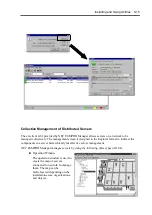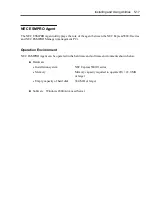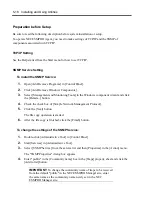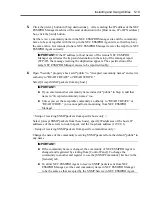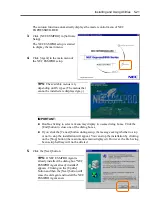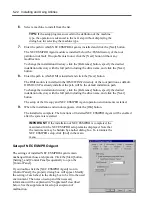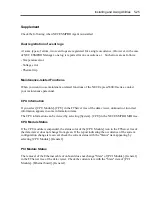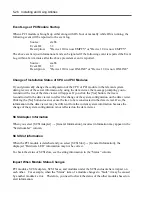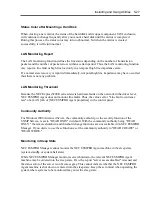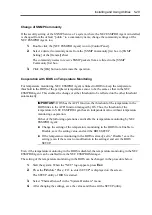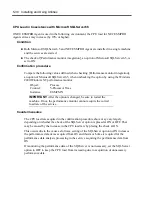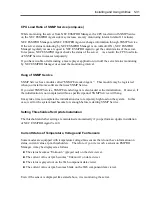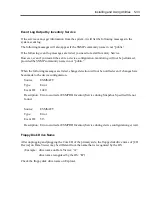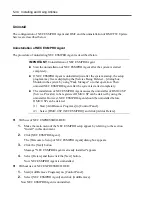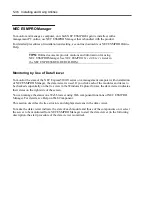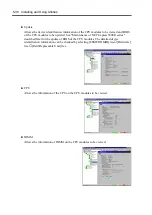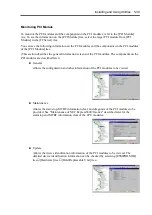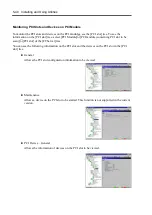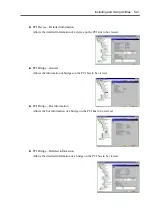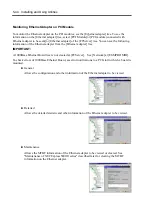
Installing and Using Utilities 5-29
Change of SNMP Community
If the security setting of the SNMP Service of a system, where the NEC ESMPRO Agent is installed,
is changed from the default “public” to a community name, change the community settings of the
NEC ESMPRO Agent, too.
1.
Double-click the [NEC ESMPRO Agent] icon in [Control Panel].
2.
Select a desired community name from the [SNMP Community] list box in [SNMP
Setting] of the [General] sheet.
The community names to receive SNMP packets from are listed in the [SNMP
Community] list box.
3.
Click the [OK] button to terminate the operation.
Cooperation with BIOS on Temperature Monitoring
For temperature monitoring, NEC ESMPRO Agent is linked to BIOS to keep the temperature
threshold in the BIOS of the peripheral temperature sensor to be the same as that in the NEC
ESMPRO Agent. This enables the change of either threshold to be reflected on the other threshold
automatically.
IMPORTANT:
If OS has the ACPI function, the threshold of the temperature in the
BIOS links to the ACPI function managed by OS. Thus, the threshold of the
temperature in NEC ESMPRO Agent has an independent value without temperature
monitoring cooperation.
Either of the following operations can disable the temperature monitoring by NEC
ESMPRO Agent:
Change the setting of the temperature monitoring in the BIOS from Enable to
Disable, save the setting value, and exit the BIOS SETUP.
If the temperature monitoring in the BIOS is already set to "Disable," save the
setting (even if there was no modification to the settings) and exit the BIOS
SETUP.
Even if the temperature monitoring in the BIOS is disabled, the temperature monitoring in the NEC
ESMPRO Agent can be enabled from the NEC ESMPRO Manager.
The setting of the temperature monitoring in the BIOS can be changed in the procedure below:
1.
Start the system. When the "NEC" logo appears, press
Esc
.
2.
Press the
F2
while "Press <F2> to enter SETUP" is displayed on the screen.
The SETUP utility of BIOS is started.
3.
Select "Thermal Sensor" in the "System Hardware" menu.
4.
After changing the settings, save the values and then exit the SETUP utility.
Summary of Contents for Express5800/320Lb FT Linux
Page 10: ...iv This page is intentionally left blank ...
Page 16: ...x This page is intentionally left blank ...
Page 19: ...Precautions for Use 1 3 Label A Label B Label C Label E Label D ...
Page 20: ...1 4 Precautions for Use Rack mount model Label B Label A Label C Label D ...
Page 21: ...Precautions for Use 1 5 Label D Label C Label B Label A ...
Page 22: ...1 6 Precautions for Use PCI CPU Modules PCI Module CPU Module Label A Label A Label A ...
Page 36: ...1 20 Precautions for Use This page is intentionally left blank ...
Page 44: ...2 8 General Description Front View inside Tower model Rack mount model ...
Page 70: ...2 34 General Description This page is intentionally left blank ...
Page 118: ...3 48 Setup This page is intentionally left blank ...
Page 162: ...4 44 System Configuration This page is intentionally left blank ...
Page 294: ...6 14 Maintenance This page is intentionally left blank ...
Page 336: ...7 42 Troubleshooting This page is intentionally left blank ...
Page 355: ...System Upgrade 8 19 15 Check the disk you selected and click Next 16 Click Complete ...
Page 399: ...System Upgrade 8 63 Cable ties included with cabinet ...
Page 410: ...8 74 System Upgrade This page is intentionally left blank ...
Page 412: ...A 2 Specifications This page is intentionally left blank ...

